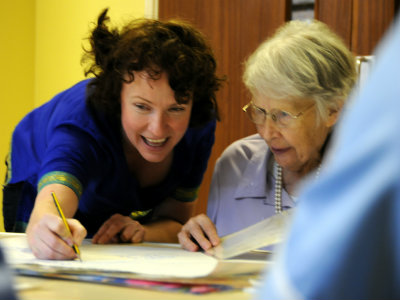
By David Savill, artistic director at Age Exchange
Reminiscence arts is a unique approach within dementia care that allows practitioners to spend time with participants and their families and to use the resulting knowledge of their life history to open a path of communication and interaction.
In 2013, Age Exchange created Reminiscence Arts in Dementia – Impact on Quality of Life (RADIQL), a three-year evaluation of the impact of reminiscence arts in improving the health and wellbeing of older people diagnosed with dementia.
The project includes work in 12 specialist and residential care settings in Lambeth and Southwark, where reminiscence arts practitioners (RAPs) are running sessions for residents with dementia, as well as delivering one-to-one activity.
RADIQL aims to provide evidence that reminiscence arts can reduce levels of isolation and unhappiness, lessen the use of anti-psychotic drugs, and improve wellbeing and social interaction between residents and care staff. Initial findings have shown that this approach is having a significant impact on the health and wellbeing of residents and benefitting staff.
Both care staff and relatives are reporting substantial improvements in residents’ health, moods and behaviour as a result of the intervention.
What is reminiscence arts?
The value of reminiscence therapy in improving quality of life for people with dementia is widely established, as is the value of arts in improving wellbeing. Reminiscence can be defined as the recall of past events, feelings, senses and thoughts to facilitate pleasure, quality of life, or adaptation to present circumstances.
It is the expression, response or exploration of the medium of arts that then defines reminiscence arts. It strengthens and enables communication and creativity between carer and care for, informing relationships in the present.
Reminiscence arts may be expressed through performance, music, dance, literature, and visual arts. It is not designed as a formal therapy and not informed by a recovery model. Importantly, it is a relationship-centred engagement approach that can be used in daily life care.
How do you become a reminiscence arts practitioner?
Reminiscence arts practitioners have usually studied an art form to graduate or postgraduate level and may combine this with an additional professional training allied to medicine, such as occupational or art therapy.
Age Exchange provides recruits with training in reminiscence practice, ethics, personal resilience and wellbeing, to enrich the artist’s already established creative knowledge, skills and experience of working with vulnerable people.
The most important thing about being a RAP is the creative background so whilst you could be a care worker or a social worker, it’s the creativity that comes from the artistic qualification that distinguishes reminiscence arts from reminiscence.
What dementia care settings can reminiscence arts be used in?
We believe that RAPs can be taken on in both private and public sector care homes. RAPs offer a way of improving relationships between residents and staff alongside improving the older person’s wellbeing, which can keep them more active and engaged. This can make it easier to care for the person so has benefits for the care scheme itself.
Our RADIQL programme is making a powerful case for a new profession of reminiscence arts practitioner in order to transform the experience of care for older people with dementia. When I see our RAPs working with people with dementia I see participants re-engaging with their community, with other residents, carers and with family.
I see levels of wellbeing rise, often dramatically, and I see older people empowered by the experience.
This is why I believe using reminiscence arts in care settings is the future of creative care for people with dementia.



 ‘Dear Sajid Javid: please end the inappropriate detention of autistic people and those with learning disabilities’
‘Dear Sajid Javid: please end the inappropriate detention of autistic people and those with learning disabilities’ Ofsted calls for power to scrutinise children’s home groups
Ofsted calls for power to scrutinise children’s home groups Seven in eight commissioners paying below ‘minimum rate for home care’
Seven in eight commissioners paying below ‘minimum rate for home care’ A groundbreaking course preparing care leavers and other young people for independent living
A groundbreaking course preparing care leavers and other young people for independent living 
 Facebook
Facebook X
X LinkedIn
LinkedIn Instagram
Instagram
Comments are closed.